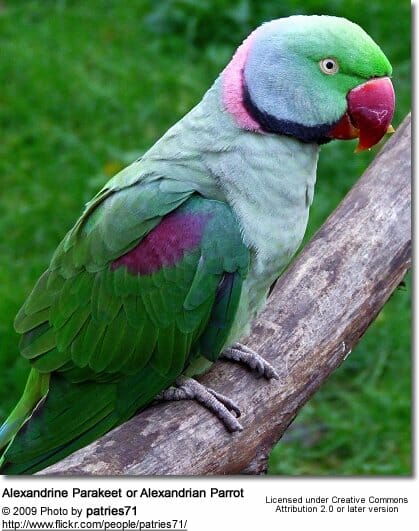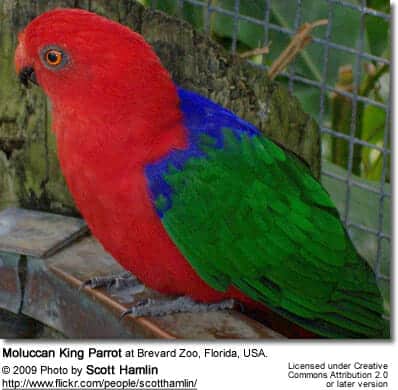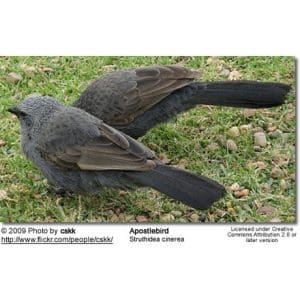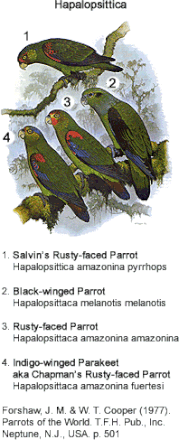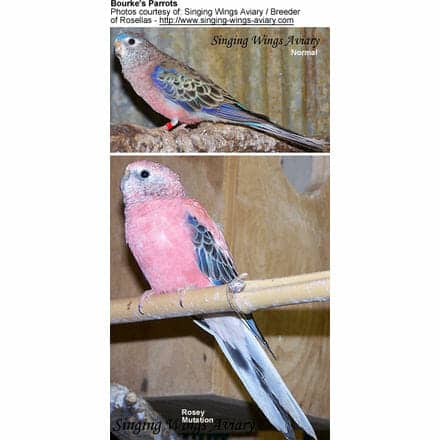Bird Species A – B

Bird Species: Index of bird species starting with letters A and B
INFO ON SPECIFIC BIRD (NON-PARROT) SPECIES
Listing of Parrot Species
Birds C-D – Birds E-G – Birds H-J – Birds K-M – Birds N-O – Birds P-Q – Birds R-S – Birds T-Z

Abessinian Parrots aka Red-bellied Parrots or Red-breasted Parrots
Abessinian Parrots aka Red-bellied Parrots or Red-breasted Parrots
The Red Bellied Parrot is similar in shape and a slightly larger bird than the Senegal Parrot, averaging 22 cm (8.5 – 8.8 ins) on length.
They usually reach maturity at 12 months of age, when they will be about 8 to 10 inches in length.
They have wide eye rings and red irises, black bills and dark gray feet. Their wings, heads and backs are greyish-brown. The lower back has a blue tinge, although it is predominantly yellow-green. The breasts, under-wing coverts, and cheeks are washed with orange. The under-wing coverts and thighs are aqua green.
Female as male, except under wing-coverts grey; breast and abdomen green. Two variations possible in immatures. Either both sexes resemble young male with much duller orange colouring and feathers with pale green edging, forehead with marked orange tinging, iris dark and adult plumage attained at 12 months or the female has green abdomen immediately.
Abessinian Parrots aka Red-bellied Parrots or Red-breasted Parrots
Abessinian Parrots aka Red-bellied Parrots or Red-breasted Parrots
The Red Bellied Parrot is similar in shape and a slightly larger bird than the Senegal Parrot, averaging 22 cm (8.5 – 8.8 ins) on length.
They usually reach maturity at 12 months of age, when they will be about 8 to 10 inches in length.
They have wide eye rings and red irises, black bills and dark gray feet. Their wings, heads and backs are greyish-brown. The lower back has a blue tinge, although it is predominantly yellow-green. The breasts, under-wing coverts, and cheeks are washed with orange. The under-wing coverts and thighs are aqua green.
Female as male, except under wing-coverts grey; breast and abdomen green. Two variations possible in immatures. Either both sexes resemble young male with much duller orange colouring and feathers with pale green edging, forehead with marked orange tinging, iris dark and adult plumage attained at 12 months or the female has green abdomen immediately.
The immatures are duller and have shorter tails.
Abyssinian Parakeets
Abyssinian Parakeets
Similar to the Rose-ringed Parakeet, krameri, but the face is pale green; breast and abdomen feathers in both sexes with marked grey-white tinge; smaller upper beak is red with a black tip.
The average length (head to tail tip) is about 40 cm (15.5 ins), with a wing length 146 – 160 mm ( 5.5 – 6 ins).
Abyssinian Parakeets, like other Ring-Necked Parakeets, are characterized by the colored ring around their necks.
The males have a rose-colored ring, while the female’s ring is less distinct and emerald-green in color. Males can also be distinguished from females by the black bib which extends from directly underneath their bill to the ring.
The bill of the Abyssinian Parakeet averages 19.6 millimeters in length and is red on the top and black on the bottom.
Adelaide Rosellas
Adelaide Rosellas
The Adelaide Rosella averages 13.5 – 14.4 inches or 35 – 36 cm in length.
The plumage is generally pale to strong orange-red. The forehead, lores (the region between the eye and bill on the side of a bird’s head) and crown are orange-red. The sides of head and nape (back of a bird’s neck) are orange-yellow. The cheeks are violet-blue. The abdomen and breast are yellow more or less strongly tinged orange-red. The bend of wing and outer median wing-coverts are bright blue. The upperside of the middle tail-feathers are dark violet-blue and with dark green base. The outer tail feathers are dark blue with bright blue edging and paler tips. The tail underside is pale bluish.
The bill is horn-colored-grey. They have narrow grey eye rings and the irides (plural of iris) are dark brown. The feet are grey.
Females are on average smaller and often suffused more with orange. The pale wing-stripe is occasionally present. They have smaller and narrower bills.
Sexing young birds can prove difficult and DNA sexing may be the only way to know for sure at a young age. However, it may be possible to sex birds that are at least 9 months as the molt into adult plumage.
Immature birds: The orange-red plumage of adults are olive-green in immatures except for the forehead, crown, upper cheek area, throat, parts of upper breast, thighs and under tail-coverts. The inner median wing-coverts and outer secondary-coverts are dull olive-green. The under wing-coverts are dull blue. The upperside of middle tail-feathers are dark olive-green with blue-black tips. The tail underside is pale grey-blue. The pale wing-stripe is present.
African Greys / Grey Parrots
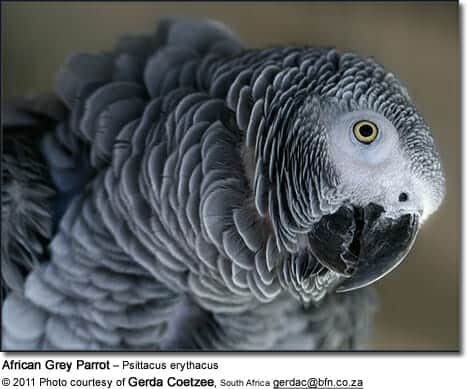
African Grey Parrot aka Grey Parrots: The Smartest Parrots of all?
These popular avian pets have the reputation for being amongst the most intelligent of all birds. They are in demand because of their human-like ability to mimic speech and generally gentle nature.
The most famous African Grey parrot was called Alex. In 1977, Dr. Irene Pepperberg purchased him from a pet store hoping to disprove that Parrots were just mimics. In the more than 30 years that she worked with him, Alex has shown amazing cognitive abilities, being able to name more than 100 objects, actions and colors. Alex was able to identify certain objects by their particular material. Sadly, Alex died in 2007.
Albatrosses
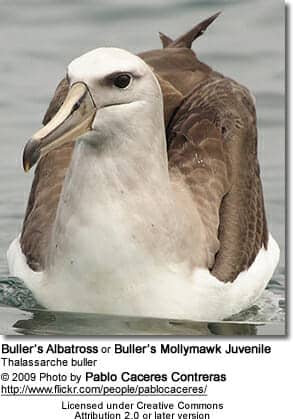
Albatrosses
They are amongst the largest of flying birds. The great albatrosses (Diomedea) specifically have the largest wingspans of any extant birds exceeding 340 cm (11 ft) – but the other species’ wingspans are considerably smaller at 1.75 m (5.7 ft). The long, slender wings are stiff and cambered, with thickened streamlined leading edges.
Alexandrine Parakeets
Alexandrine Parakeets
The Alexandrine Parakeet is a large Parakeet species measuring 58 cm (23 in) in total length with a wingspan averaging 18.9–21.5 cm (7.5–8.5 in).
They weigh between 8.75 –
9.1 oz (250-260g)
It is mainly green with a blue-grey sheen on its cheeks and napes (back of a bird’s neck), particularly in males. The abdomen is yellowish-green, the upperside of the middle tail feathers is blueish-green, the upperside of the external tail feathers is
green while the underside of the tail feathers are all yellow.
All Alexandrine Parakeets (irrespective of age, gender and/or sub-species) boldly display a maroon (reddish-brown) patch at the top of their wing coverts (commonly called ‘shoulder’ patch). The shoulder patch is seen in parakeets at their first feathering before fledging from their nests. The lower and upper mandible are red with yellow tips. The adult’s irises are yellowish-white and the periopthalmic rings are light grey. The legs are grey except in the P. e. siamensis (Laos’ or Siamese sub-species) where they are yellowish-grey.
The species is dimorphic in adulthood (3 years and older). The immatures are monomorphic and are similar but duller in appearance to that of the adult females. Adult males always show pitch-black neck rings and large pink bands on their napes (commonly called nape bands). Often males only display a little band of blueish-grey above their bold pink nape-bands. Adult females frequently show neck ring shadows that are anywhere between light and dark shades of grey. Females never display true black feathers in their neck-rings. Immatures of either genders are very similar to adult females but as with all genuine parakeet species, the young Alexandrine Parakeets always display shorter middle-tail feathers and thus shorter tails than adults. The adult feathering usually is acquired between 18–30 months of age, but may sometimes show up as young as 12 and/or as old as a full 36 months of age. Consequently, it may be difficult to identify the sex Alexandrine Parakeets by sight with absolute certainty until they are a full 36 months of age.
Alpine Parakeets aka Orange-fronted Parakeets
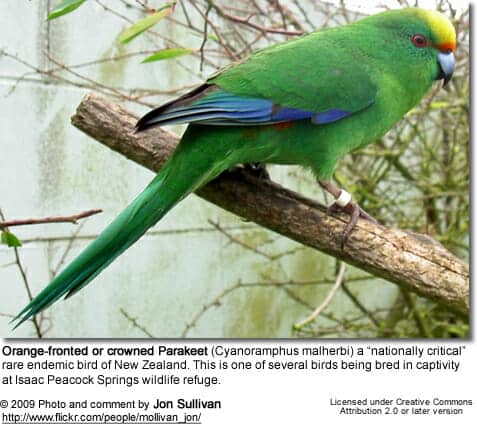
Orange-fronted or Red-fronted Parakeet, Cyanoramphus malherbi
The Malherbe’s Parakeet is from 20 – 23 cm or 7.8 – 9 inches long (including the tail). Males usually weigh between 45 – 55 g; females between 38 – 50 g.
The plumage is mostly bright green with a distinctive orange frontal band (from eye to eye). The forecrown is pale lemon-yellow. It has orange patches on each side of the rump. The outer webs of the flight feathers are purple-blue. The bill is blue-grey, tipped with black – with a black cutting edge. The eyes are red.
Amboina King Parrots aka Moluc
can King-Parrot, Amboina Green-winged King Parrot
Amboina King Parrots aka Moluccan King-Parrot
These parrots can only be described as serene, sophisticated and strikingly beautiful due to their well-defined, bright coloration of their plumage.
At 14.8 inches (37 centimeters), the Amboina King Parrot is considered one of mid-size to larger parrot breeds. They primary plumage is red, with bright green wings, bright blue backs, rumps, tail coverts and wing coverts. The top of the tail is usually black with vivid blue highlights. Their underside is dark gray or black with pink markings on the margins and their feet are gray.
Males and females look alike and DNA testing is necessary to determine the sex of your bird.
They are physically and sexually mature at twelve months of age. The average clutch consists of 3 eggs which are incubated for about 21 days.
Ancient Murrelets
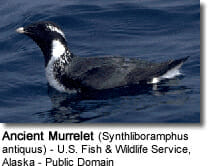
Ancient Murrelets
The Ancient Murrelet, Synthliboramphus antiquus, is a bird in the auk family. It breeds from the Yellow Sea (islands off China), through the Russian Pacific coast and the Aleutian Islands to the Haida Gwaii archipelago of British Columbia, where about half of the world population breeds.
These birds breed in colonies, their two eggs (sometimes one) are laid in burrows excavated in forest soil among tree roots, under logs or in grass tussocks, occasionally in rock crevices. These small auks arrive at and depart from their nesting grounds at night, presumably to reduce predation, and perhaps for the same reason the young are never fed at the nest, being taken to sea 1-3 days after hatching. The parents and young recognise one another by call and after the chicks have run from the burrow to the sea, they locate their parents by call and the entire family swims immediately out at sea. The family continues to move away from land for at least twelve hours. After that, the young are fed exclusively at sea by their parents for more than a month.
Some Ancient Murrelets move south in winter as far as California, and odd birds are found inland in North America, carried by autumn storms. The most remarkable record of this relatively short-distance Pacific migrant was a bird found on Lundy, Devon in spring 1990. Even more remarkably, the same bird returned to this British island the following spring.
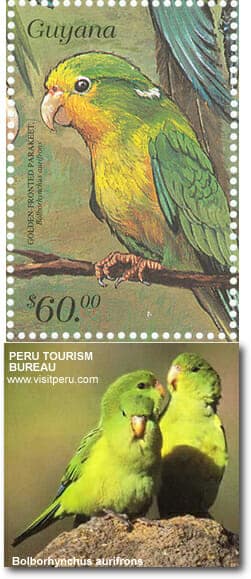
Andean Parakeets
Andean Parakeets
Size: This small parrot averages 6 to 8 inches (~ 17 to 20 cm) in length.
Adult Male: The plumage is dull green. The forehead, lores (the region between the eye and bill on the side of a bird’s head) and chin are lightly tinged with yellow. The throat, breast, abdomen and thighs are yellowish-olive green. The greater under wing-coverts are bluish-green. The primaries (longest wing feathers) have a pale bluish-green to the outer webs. The tail underside is bluish-green. The bill is greenish-grey. The irides (= plural of iris) are dark brown; and the cere (soft skin surrounding the nostrils) and feet are dark pinkish-flesh in color.
Females have less or lack the yellowish tinge to the forehead, lores (the region between the eye and bill on the side of a bird’s head) and chin. The tail is mostly more pointed than the male’s.
Immatures look like females but have shorter tails.
Anhingas
Anhingas aka Snakebirds, Darters, American Darters, or Water Turkeys
The Anhingas (Anhinga anhinga) are found in the warmer parts of the Americas. They are members of the darter family and are related to pelicans and cormorants.
These water birds are also commonly referred to as Snakebirds, Darters, Water Crows, American Darters or Water Turkeys.
The word “anhinga” is derived from the Brazilian Tupi language and means devil bird or snake bird.
The Creoles of Louisiana refer to it as “Bec a Lancette,” on account of the pointed shape of the bill. In Southern Florida, this bird is known as the “Grecian Lady.”
Anis
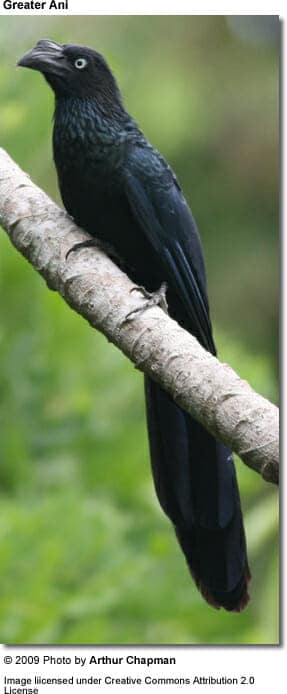
Anis (Crotophagidae / Crotophaginae)
Anis are essentially tropical New World birds, although the range of two species just reaches the United States.
These gregarious species are usually found in noisy flocks.
Antbirds

Dull-mantled Antbirds
The antbirds are found across subtropical and tropical Central and South America, from Mexico to Argentina.
This genus consists of more than 200 species, known variously as antshrikes, antwrens, antvireos, fire-eyes, bare-eyes and bushbirds. Most species live in forests, although a few are found in other habitats.
They are diurnal, feeding, breeding and defending territories during the day.
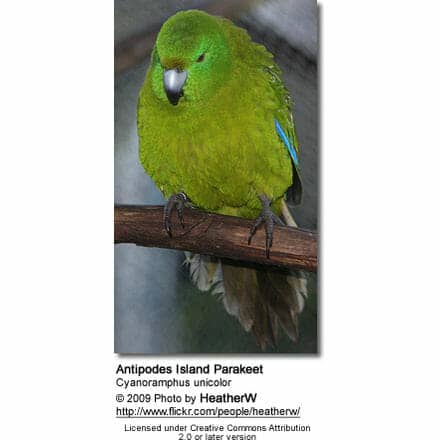
Antipodes Island / Green Parakeets
Antipodes Island / Green Parakeets
It is the largest and most specialized Kakariki and the largest of the Cyanoramphus (kakariki) species, averaging 12 inches or 30 – 31cm in length (including the tail) – 3 cm or 1.2 inches longer than the New Zealand red-crowned parakeet.
The Antipodes Island parakeet is the only member of the kakariki family with all green coloring, and without a colored frontal head band. Its general plumage is green. The breast, abdomen and under tail-coverts are yellowish-green. The outer webs of its flight-feathers are violet-blue. The irises are orange; the feet are grey. It has a pale bluish-grey beak with blackish tip.
Apostlebirds
Apostlebirds
The Apostlebird (Struthidea cinerea), also known as the Grey Jumper, is a quick-moving, gray or black bird about 13 inches (33 centimetres) long. It is a native to Australia where it roams woodlands, eating insects and seeds at, or near, ground level. Apostlebirds always seem to travel in groups of about 12; for this reason they were named after the Biblical apostles – the twelve chief followers of Jesus Christ.
Aracari
Aracaris (Toucans)
The aracaris (or araçaris – genus Pteroglossus) are medium-sized Toucans that are brightly plumaged and sport large colorful beaks.
The aracaris inhabit the warm rainforests of Central or South America – where are typically found high up in the forest canopy.
They are resident breeders and do not migrate – although some species may move seasonally within their range.
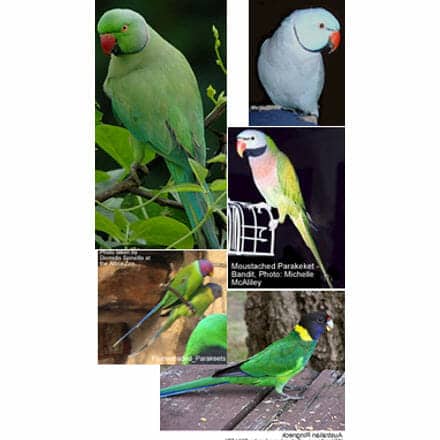
Asiatic, African Parakeets
Asiatic, African Parakeets / Ringneck or Long-tailed Parakeets
The vibrant and colorful ringneck parrots are visually appealing and tame easily. Most of them readily breed in captivity resulting in an ample supply of young birds for the pet trade.
Owners describe them as smart birds that learn concepts quickly and love to show off. Many of them are very talented talkers, speaking with a clarity that can easily be compared to that of the Quakers, Grays and Amazons – species well known for their talking abilities. Contrary to rumors, both the male and the female are capable of speech. They learn words and phrases in a very short span of time without any training for the most part. They just learn by listening. Of course, should training be provided, their vocabulary can be significantly increased.
Astrapia
Astrapia
The genus Astrapia (Vieillot, 1816) consists of five species of birds of paradise.
They are endemic to New Guinea.
The males have highly iridescent plumage and very long tails.
Auks / Auklets
Uria – Auks
Auks have long bodies, short tails, small wings and short legs that set far back on the body.
They are superficially similar to the unrelated penguins; however in contrast to penguins, the modern auks are able to fly (with the exception of the recently extinct Great Auk).
They are good swimmers and divers, but their walking appears clumsy. Due to their short wings auks have to flap their wings very quickly in order to fly.
Australian King Parrots aka Eastern Kings, Queensland Kings, King Lories, Scarlet Parrots, Green Parrots
Australian King Parrots aka Eastern Kings, Queensland Kings
Adults of both sexes are very majestic birds, typically averaging 42 – 43 cm (16 – 17.2 inches) in length, including their long tail.
The adult (>4 years) males are very striking in appearance with a red head, breast, and lower undersides, with a blue lower back, and green wings and tail. They have a reddish-orange upper beak with a black tip and a black lower beak, and yellow eye ring.
These parrots are sexually dimorphic.
Females are similar in appearance except for a green head and breast, a black upper beak, and paler yellow eye ring. Please refer to the below photos.
Juveniles of both sexes resemble the females.
There is one subspecies, A.s. minor, which is found at the northern limit of its range, and is typically about 5 cm (2 inches) shorter than the nominate species but otherwise is similar in appearance.
Avocets (Recurvirostridae)
Avocets
They are typically found in warm climates.
They had been extinct in Britain for a long time because of land reclamation of their habitat and persecution by skin and egg collectors, but during or soon after World War II started breeding on reclaimed land near the Wash which was returned to salt marsh to make difficulties for any landing German invaders.
Babblers
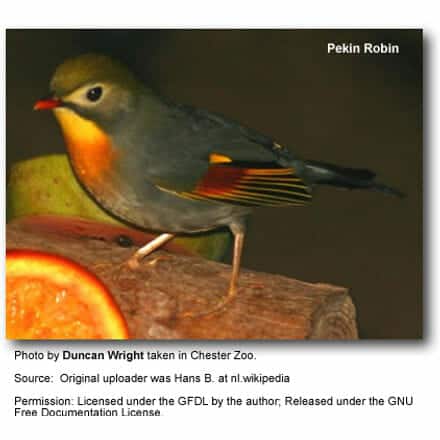
Old World Babblers
Babblers is a large family of birds mostly found in the Old World (Europa, Asia and Africa), where they occur in tropical areas, with the greatest variety occurring in Southeast Asia. They are mostly resident (non-migratory).
They vary in size and coloration, but all have a soft, fluffy plumage. These birds have strong legs, and many are quite terrestrial. This group is not strongly migratory, and most species have short rounded wings and are weak flyers.
Babblers are generally social birds that are usually found in family groups and small flocks of up to about 20 individuals – typically foraging on the ground and loudly calling to one another. These opportunistic omnivores will feed on meat, plant material and / or berries.
Barbets
Barbet Bird
Barbets consists of about 75 species of brightly colored tropical birds constituting the family Capitonidae (order Piciformes) and are related to the toucans.
The barbets get their name from the bristles which fringe their heavy bills.
These big-headed, short-tailed birds are 3.5 – 12 inches (9–30 cm) long and have stout, sharp bills with bristles at the bases.
Their plumage is greenish or brownish, with splashes of bright colors or white. The smallest barbets are known as tinkerbirds.
Barn Owls
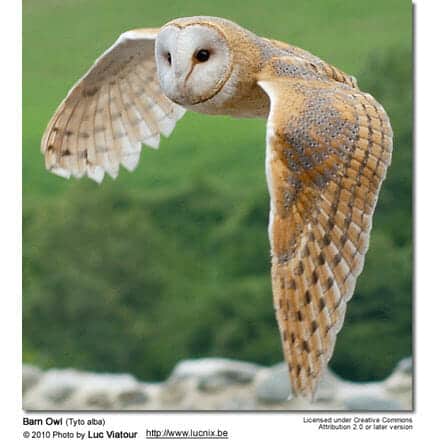
Barn Owls (Tytonidae)
The Barn Owl (Tyto alba) is the most widely distributed species of owl, and one of the most widespread of all birds. It is also referred to as Common Barn Owl, to distinguish it from other species in the barn-owl family Tytonidae. These form one of two main lineages of living owls, the other being the typical owls (Strigidae).
It is known by many other names, which may refer to the appearance, call, habitat or the eerie, silent flight: White Owl, Silver Owl, Demon Owl, Ghost Owl, Death Owl, Night Owl, Rat Owl, Church Owl, Cave Owl, Stone Owl, Monkey-faced Owl, Hissing Owl, Hobgoblin or Hobby Owl, Dobby Owl, Golden Owl, Scritch Owl, Screech Owl, Straw Owl, Barnyard Owl and Delicate Owl. “Golden Owl” might also refer to the related Golden Masked Owl (T. aurantia). “Hissing Owl” and, particularly in the USA, “screech owl” refer to the piercing calls of these birds, but the latter term usually refers to typical owls of the genus Megascops.
Bats

Bats: Flying Mammals Active at Night
Even though Bats belong to the Mammal family, rather than being classified as “birds,” I still included them on this website in the spirit of public education and the conservation of this intriguing and highly useful animal. And well, they DO fly!
Bee Eaters
Blue-tailed Bee-eaters
They are mostly found in Africa, although some species occur in southern Europe, Madagascar, Australia, India and New Guinea (and other islands in the South Pacific).
Most bee-eater species are migratory and may travel thousands of miles to their favorite breeding or wintering sites. A few exceptions may travel short distances in response to the rainy and dry seasons, such as the African Little Bee-eater.
Bellbirds
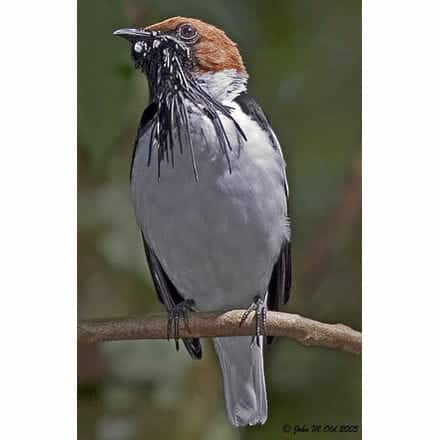
White Bellbirds
South American Bellbirds (or simply ‘bellbirds’) are members of the cotinga family that are mostly found in South America. In some parts of their range, they are sometimes referred to as “araponga.”
Birds of Paradise
Blue Birds of Paradise
The Birds of Paradise or Cendrawasih are members of the family Paradisaeidae of the order Passeriformes (Perching Birds).
Listing of Species (including hybrids and formerly included species)
Bitterns
Little Bitterns
Bitterns are short-tailed and short-necked wading birds that have a global presence with subspecies occurring in Europe, Africa, Australia, Asia and Americas. They are usually found in reef beds and similar marshy / wetland areas.
They fly with their necks retracted.
They mostly feed on amphibians, reptiles, insects and fish
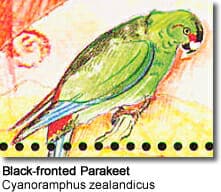
Black-fronted Parakeets, Tahiti Parakeets
Black-fronted Parakeets or Tahiti Parakeets
This parakeet averaged 25 cm or 10 inches in length (including its tail).
The plumage was mostly green / olive-green, with a bluish tint to the breast, abdomen under tail-coverts and tail. The forehead was black. The lores (the regions between the eyes and bill on the side of a bird’s head) and stripe across eye were red. The lower back was red. The outer webs of flight-feathers were violet-blue. They had light blue eye-rings. Adults most likely had orange irises, while young birds had dark/brownish eyes. The feet were greyish-brown and the bill was pale bluish-grey with a blackish tip.
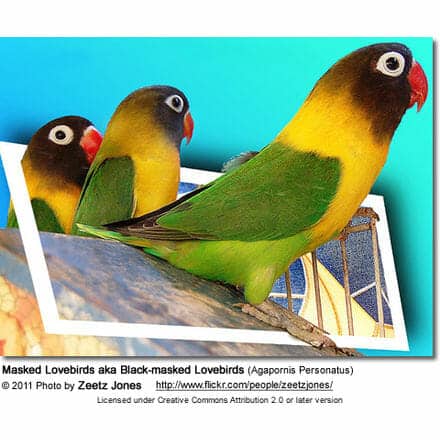
Black-masked Lovebirds aka Masked Lovebirds (Eye-rings)
Black-masked Lovebirds aka Masked Lovebirds (Eye-rings)
Masked lovebirds average 6 inches or 14.5 cm in length. The naturally occurring masked lovebirds have a green body color. The head is mostly black and the color of its plumage is except for a few highlights green with a yellow collar. However, other mutations — specifically blue and yellow — have been bred in captivity.
Black-winged Parrots (Hapalopsittaca melanotis) or Black-eared Parrots
Black-winged Parrots (Hapalopsittaca melanotis) or Black-eared Parrots
This small stocky parrot averages 23 – 24 cm (9 – 9.5 ins) in length (including tail).
Adults: The plumage is mostly green with large black patches on the wings, dull yellow around eyes, and distinct patches over the ears. The head is bluish green to slate blue. They have blue lores (regions
between the eye and bill on the side of a bird’s head) and a narrow frontal band. A blue band can also be seen across the nape (the lower back of the head). The breast and throat are bluish turning yellowish-green on the abdomen. The edge of the wing and under wing-coverts are bluish-green. The upper side of the tail is green with violet-blue tips and the underside is dusky bluish-green.
Their beak is light blue-grey, the irides (= plural of iris) are yellowish-green and the narrow eye rings (periophthalmic rings) are blackish, and the feet are grey.
Immature birds / juveniles have pronounced green on greater and median wing-coverts. The bill is grey and the irides (= plural of iris) are dark.
Blackbirds

Blackbirds
The Blackbird or Common Blackbird (Turdus merula) is a European member of the thrush family Turdidae. The blackbird is the national bird of Sweden.
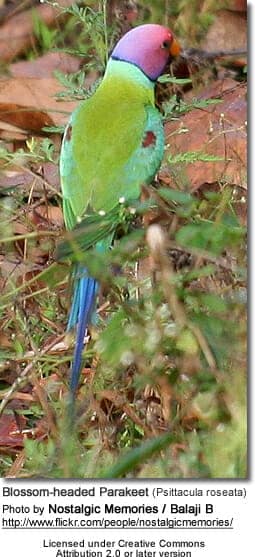
Blossom-headed Parakeets
Blossom-headed Parakeets
This is a green parrot, about 12 inches (30 cm) long with the tail accounting for more than half of that length. They weigh, on average, 2.5 to 3 ounces (~ 75 – 85g).
The male’s head is pink becoming pale blue on the back of the crown, nape (back of the neck) and cheeks. There is a narrow black neck collar and a black chin stripe. There is a red shoulder patch and the rump and tail are bluish-green, the latter tipped yellow. The upper beak is yellow, and the lower beak is dark.
The female has a pale grey head and lacks the black neck collar and chin stripe patch. The lower beak (mandible) is pale. Immature birds have a green head and a grey chin. Both upper and lower beak are yellowish and there is no red shoulder patch.
Female attain their adult plumage at 15 months and males by 30 months.
There are a couple of possible mutations listed on www.psittacula-world.com

Blue Bonnet Parrots
Blue Bonnet Parrots
The Blue Bonnet or Yellow-vented Blue-bonnet Parrot (Northiella haematogaster haemetogaster or Psephotus haematogaster haematogaster) is endemic to western and southern New South Wales, north-western Victoria and south-eastern South Australia
Blue Bonnet parrots are sporadically dispersed, socially gathering in groups of up to 30 birds.
They permanently mate. Their courtship ritual is quite entertaining and entails fanning and shaking of their tail feathers, raising their crown feathers and a lot of head bobbing.
They nest in low-lying tree openings lined with wood substances. The average nest consists of 4 to 7 eggs, which are incubated by the female for about 22 days.
The male assists in rearing the young and feeds the female on the nest.

Blue-backed Parrots
Blue-backed Parrots aka Müller’s (or Mueller’s) Parrots
This is a medium size parrot, averaging 32cm in length. The plumage is basically green with yellow-streaked wings, a blue rump, and blue wing bends. The head, mantle, wings and tail are darker green, the belly and collar are lighter green.
The blue-backed parrots are sexually dimorphic (most parrots aren’t) – the male can be identfied by his red beak and the female by her pale yellow or horn-colored beak.
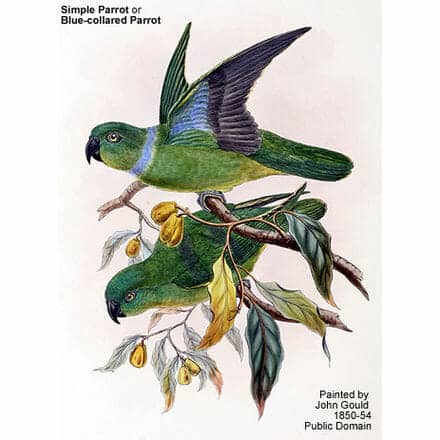
Blue-collared Parrots
Blue-collared Parrots (Geoffroyus simplex)
The Blue-collared Parrot aka Simple Parrot averages ~8.5 inches (22 to 23 cm) in length (from head to tip of the tail) and weighs ~ 6.8 oz (195 g).
Its plumage is mainly green with a black beak. The forehead, sides of head, breast, abdomen, upperside of tail, upper and under tail-coverts are yellowish-green. They have yellow wing bends, blue underwing coverts and a pale yellow iris.
Adult males have a blue collar across upper breast to lower neck above the mantle.
Females lack the blue collar, but have a bluish tinge to the crown and nape (back of the neck).
Immature birds look like females, but other than a faint bluish tinge, there is no blue visible. They have a paler bill.

Blue-crowned Hanging Parrots
Blue-crowned Hanging Parrots or Malay Lorikeets
This is a small parrot, averaging 4 to 5 inches (12 to 13 cm) in length and weigh about 1 oz (28 g).
The plumage is generally green. The breast, abdomen and under tail-coverts are yellowish-green. Males have a distinctive dark-blue patch to the crown and a red throat patch. The lower back and upper tail-coverts are red. The back has a yellowish tinge. A yellow band can be seen across the lower back. The under wing-coverts and underside of the wings are greenish-blue. The upperside of the tail is green and the underside is greenish-blue. They have black bills and dark brown irises. Their feet are brownish-flesh colored.
Hens have a duller plumage. Her breast, abdomen and under tail-coverts are more yellowish. The blue patch to the crown and the yellowish tinge to the back is faint. They lack the red throat patch of the male.
Young birds look like females, but their feathers have a narrow dark edging. The forehead is grey with a bluish tinge. The lack the blue patch to the crown that can be seen in the mature male. The lower back is interspersed with green. The bill is pale horn-colored and their feet are brownish.

Blue-crowned Parrots aka Blue-naped Parrots
Blue-naped Parrot, known as Luzon Parrot or Philippine Green Parrot
This medium-sized parrot averages 12.4 inches or 31 cm in length. The plumage is primarily green except for a light blue rear crown and nape (back of the neck). It has a pale blue lower back and rump, scalloped shoulders with orange-brown on black coverts, and blackish underwings with green underwing coverts.
Blue-crowned Racket-tailed Parrots
Blue-crowned Racket-tailed Parrots
The Blue-crowned Racket-tailed Parrot averages 27cm in length. The plumage is basically green with a blue crown, blueish undertail, whitish beak, and dark underwings with green coverts.
The Salomonsen’s Racket-tailed Parrots average 27 cm (10.5 ins) in length. They look like the Blue-crowned Racket-tailed Parrot described above, but with less blue on head, the blue center of the crown is not as clearly defined, gradually merging with green on sides of head.
Distribution and Status in the Wild: CITES II – Endangered … Distribution: Negros, Bohol, Samar, Leyte, Masbate, Cebu in the Philippines
Taxonomy: Species: Scientific: Prioniturus discurus whiteheadi … English: Salomonsen’s Racket-tailed Parrot … Dutch: Salomonsens Vlagstaartpapegaai … German: Salomonsen Spatelschwanzpapagei … French: Perroquet à raquettes de Whitehead
Blue-footed Boobies
Blue-footed Boobies
The Blue-footed Booby (Sula nebouxii) is a bird in the Sulidae family which comprises ten species of long-winged seabirds.
The name “booby” comes from the Spanish term bobo, which means “Stupid”. This is because the Blue-footed Booby is clumsy on the land. Like other seabirds, they can be very tame.
The natural breeding habitat of the Blue-footed Booby is tropical and subtropical islands off the Pacific Ocean, most famously, the Galápagos Islands, Ecuador.

Blue-headed Parrot (Pionus menstruus)
Blue-headed Parrot (Pionus menstruus)
The Blue-headed Parrot (Pionus menstruus) – also known as the Blue-head Amazon or Red-vented Parrot, is endemic to tropical Central and South America, from Costa Rica and Trinidad south to Bolivia and South to Central Brazil.
They inhabit forests and terrain with trees up to a height of 600m or 2000ft, but are occasionally seen up as high as 1500m or 5000ft – however, only in favored feeding places in open country and cultivated areas.
During breeding season they fly in large flocks and can be seen in the mornings flying from the regular breeding sites to their feeding areas. At dawn or at dusk, large numbers of them are seen roosting communally in palm and other trees.
Longevity: “You and Your Pet Bird” by David Alderton states that Pionus live an average of 25 years. Pionus can live to be over 40 and often they live only 3 or 10 years due to accidents and poor nutrition.
Blue-headed Racket-tailed Parrots
Blue-headed Racket-tailed Parrots aka Palawan Racquet-tail Parrots
This parrot averages 10 inches 26 to 28cm) in length. The plumage is basically green with a bright, light blue head, blue under wings (except for green coverts) and, in the male, bluish breast. The beak is bluish gray and iris is yellowish.
Female is restricted to blue on crown and sides of head. Her breast and abdomen are pale green with traces of blue. .
These are medium-noisy parrots, and can occasionally get loud. Their cries resemble the call of a buzzard – generally melodious.
Blue-rumped Parrots
Blue-rumped Parrots
This small parrot – averaging 7.2 inches or 18 cm in length – is primarily green, with bright red shoulder patches, and yellowish margins on the wing coverts.
The male has a black mantle, red upper beak, and greyish-blue head and rump, with a brighter blue to the forehead and crown. The breast and abdomen are greyish-olive. The thighs and under tail-coverts greenish-yellow with bluish tips. The back is blue-black with each feather edged greenish-grey. The lower back and upper tail-coverts are deep blue. The sides of the body and the wing-coverts and bend of wing are red. The outermost lesser wing-coverts are brownish-red. The wings and greater wing-coverts are dark green. The secondaries (shorter, upper “arm” feathers) and wing-coverts have a greenish-yellow edging. The upperside of the tail-feathers are greenish-yellow and the underside is yellow. The upper beak of the male is red and his lower beak is brown-blackish. The irises are pale yellow and the feet are grey.
This species is sexually dimorphic (which means that males and females can be visually sexed – once they have gained their adult plumage).
Females look similar to the male except hens have a grey-brown head. Her ear-coverts are tinged olive-yellow. The back, lower back and upper tail-coverts are green. There is a bluish patch to the lower back. The breast and abdomen are yellowish-green. The outer under wing-coverts are green. Both the upper and lower beaks of the hen are brown-blackish, while the upper beak of the male is red.
Immature birds look like females, but their head is green. Young males usually have a bluish tinge to forehead; under wing-coverts partially red. The irises are greyish-yellow.
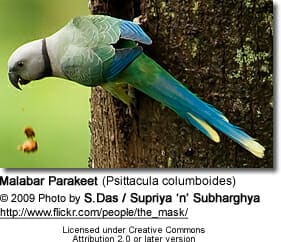
Blue-winged Parakeet
Malabar Parakeets aka Bluewinged Parakeets, Blue Winged Parakeets
The average adult Malabar Parakeet measures 15 inches (38 centimeters) in length. The Malabar Parakeet has beautifully colored plumage. The male’s overall color is a bluish-gray with a sometimes reddish-pink tint. One of the things that make this bird so striking is the double ring around the neck of the male. The lower ring is a brilliant light blue, while the top ring is more of a greenish dark gray color. They have green feathers in front of their eyes, which extend towards their beaks. The plumage on their heads is bluer in color than the rest of their bodies, though it gets progressively lighter at the top of the head. Above the nares and on the cheeks the blue color is more distinct. They have a striking bright red beak with a bone-colored tip.
The female Malabar Parakeets lack the brilliant blue band around their necks. Males generally have a greener casting to the feathers on their foreheads, and female’s heads are gray. The bill of the female is black, as opposed to the brilliantly color bill of the male.
Young / immature parakeets can be distinguished from adults by their orange beaks. They have plumage similar to that of the female, after their first molt they get their adult plumage, and their beaks will change to red for males and black for females.
Bluebirds
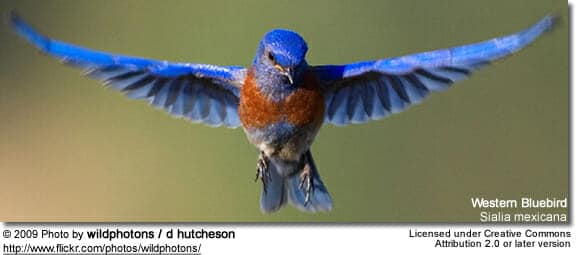
Western Bluebirds
Bluebirds are territorial, mostly insectivorous or omnivorous birds that are restricted to the Americas.
Their preferred habitat consists of open areas with scattered trees nearby for perching and roosting; such as pastures, orchards, golf courses, parks and the edges of meadows. They may also nest outside of towns and cities
Bluethroats
Bluethroats
The Bluethroat (Luscinia svecica) is a small passerine bird that was formerly classed as a member of the thrush family Turdidae, but is now more generally considered to be an Old World flycatcher, Muscicapidae.
It, and similar small European species, are often called chats.
Blyth’s Parakeets

Nicobar Parakeets or Blyth’s Parakeets
Size: The average length is 19 – 23 inches (48 – 56 cm), with a wing span of 7.5 – 8 inches ( 190 – 206 mm). It is considered the largest of the “true parakeets” in terms of length.
Adult Male: The plumage is mostly green. The head is grey. The nape (back of the neck) and crown have a faint blue tinge. The cheeks and ear-coverts have a light yellowish tinge. Chin, broad stripe to cheek. The lores (the regions between the eyes and bill on the side of a bird’s head) and forehead are black. The upperside of the middle tail-feathers are green tinged with grey and with yellow tips. The outer tail-feathers are green. The underside of the tail-feathers are green-olive yellowish. The upper beak is red and the lower beak is black. The irides (= plural of iris) are orange-red and the feet grey.
Female as male, but her nape (back of the neck) and crown are suffused strongly with blue. Both upper and lower beaks are black. The middle tail-feathers, on average, are noticeably shorter.
Bobolinks
Bobolinks
Bobolinks measure 16–18 cm (6–8 in) in length with short finch-like bills.
Adult males are mostly black, although they do display creamy napes, and white “shoulder feathers” (scapulars), lower backs and rumps.
Adult females are mostly light brown, although their coloring includes black streaks on the back and flanks, and dark stripes on the head; their wings and tails are darker.
Bobwhites

Bobwhite Quails, Northern Bobwhites, or Virginia Quails
A booby is a seabird in the Sula genus, part of the Sulidae family. Boobies are closely related to the gannets (Morus), which were formerly included in Sula.
Their name was possibly based on the Spanish slang term bobo, meaning “dunce”, as these tame birds had a habit of landing on board sailing ships, where they were easily captured and eaten. Owing to this, boobies are often mentioned as having been caught and eaten by shipwrecked sailors, notably Captain Bligh of the Bounty and his loyalists, during their famous voyage after being set adrift by Fletcher Christian and his mutineers.
Bobwhites
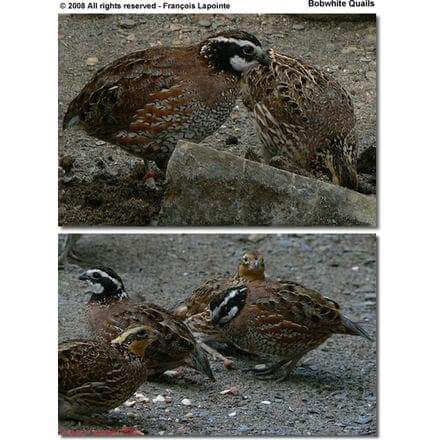
Bobwhite Quails, Northern Bobwhites, or Virginia Quails
The Bobwhite Quail, Northern Bobwhite, or Virginia Quail, Colinus virginianus, is a ground-dwelling bird native to North America. The name derives from their characteristic call.
The Bobwhite Quail is a member of the group of species known as New World quail. It is a popular gamebird, particularly in the US Southern States, forming what are known as “coveys”, groups of five to 30 birds, during the non-breeding season (roughly October-April). Quail primarily inhabit areas of early successional growth dominated by various species of pine, hardwood, woody, and herbaceous growth. However, quail habitat varies greatly throughout their range which extends from Mexico east to Florida and north into the Upper Midwest and Northeast.
Boobies
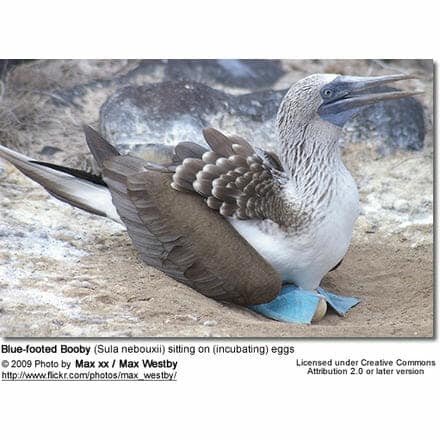
Boobies
A booby is a seabird in the Sula genus, part of the Sulidae family. Boobies are closely related to the gannets (Morus), which were formerly included in Sula.
Their name was possibly based on the Spanish slang term bobo, meaning “dunce”, as these tame birds had a habit of landing on board sailing ships, where they were easily captured and eaten. Owing to this, boobies are often mentioned as having been caught and eaten by shipwrecked sailors, notably Captain Bligh of the Bounty and his loyalists, during their famous voyage after being set adrift by Fletcher Christian and his mutineers.
Bourke’s Parrots aka Bourke Parakeets, Rosey Bourkes
Bourke’s Parrots aka Bourke Parakeets, Rosey Bourkes or Bourke Grass Keets
The natural color of the Bourke’s Parakeet is basically brown, with pink abdomen, pinkish breast and a blue rump. The legs are dark-brown, with zygodactyl toes (the toes are arranged in pairs, the second and third toes pointing forward; the other two toes pointing backwards). The bill is yellowish-brown.
This parakeet can be visually sexed. Adult males have blue brown crowns while adult hens have white brows and hens and juveniles have a full grey head.
In the normal form the head and back are a scaled grey with the chest and abdomen being a pink shade. The wings and tail are etched in blue. To the right, there are photos of the beautiful pink mutation.
Bowerbirds
Bowerbirds
The most notable characteristic of bowerbirds is the extraordinarily complex behaviour of males, which is to build a bower to attract mates. Depending on the species, the bower ranges from a circle of cleared earth with a small pile of twigs in the center to a complex and highly decorated structure of sticks and leaves — usually shaped like a walkway, a small hut or a maypole — into and around which the male places a variety of objects he has collected. These objects — usually strikingly colored — may include hundreds of shells, leaves, flowers, feathers, stones, berries, and even discarded plastic items or pieces of glass. The bird spends hours carefully sorting and arranging his collection, with each object in a specific place; if an object is moved while the bowerbird is away he will put it back in its place. No two bowers are the same, and the collection of objects reflects the personal taste of each bird and its ability to procure unusual and rare items (going as far as stealing them from neighboring bowers). At mating time, the female will go from bower to bower, watching as the male owner conducts an often elaborate mating ritual and inspecting the quality of the bower. Many females end up selecting the same male, and many underperforming males are left without mates.
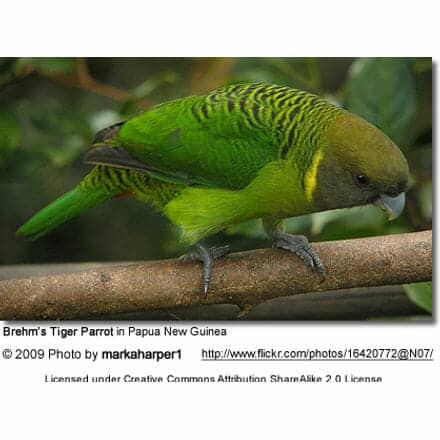
Brehm’s Parrots
The Brehm’s Parrot aka Madarasz’s Parrot or Painted Parrot
This small parrot averages 24 cm (9.5 ins) in length (including tail). The wing length is 118 – 124 mm (4.5 – 5 ins).
Males: The plumage is mainly green with a dull olive brown head, yellow and black bars on the mantle, back and rump, and red undertail coverts. The males have a distinctive yellow crescent on the side of the neck.
Females have a darker head, lack the yellow crescent (although some may have variable yellowing tinge to the nape. Hens also have a barred breast.
Young (immature) birds look like hens, but the green breast is narrowly edged with yellow.
Their flight is slow with rapid, noisy wing beats.

Broad-billed Parrots
Broad-billed Parrots
This was a large, heavy-set parrot,.
The males were similar in size to the Palm Cockatoo. The females were considerably smaller.
It had a long tail and a reduced flight apparatus and was probably flightless.
The bill was very large but comparatively weak and probably adapted to crush the pulp of large fruits so that they could be swallowed, pit and all.
The color was a bluish gray overall, and there was a small frontal crest. The discovery of the structure of the bill (which was previously thought to be adapted to cracking nuts) has led to the hypothesis that this bird, not the dodo, was one of the main animals responsible for propagation of the Tambalacoque or “dodo tree”.
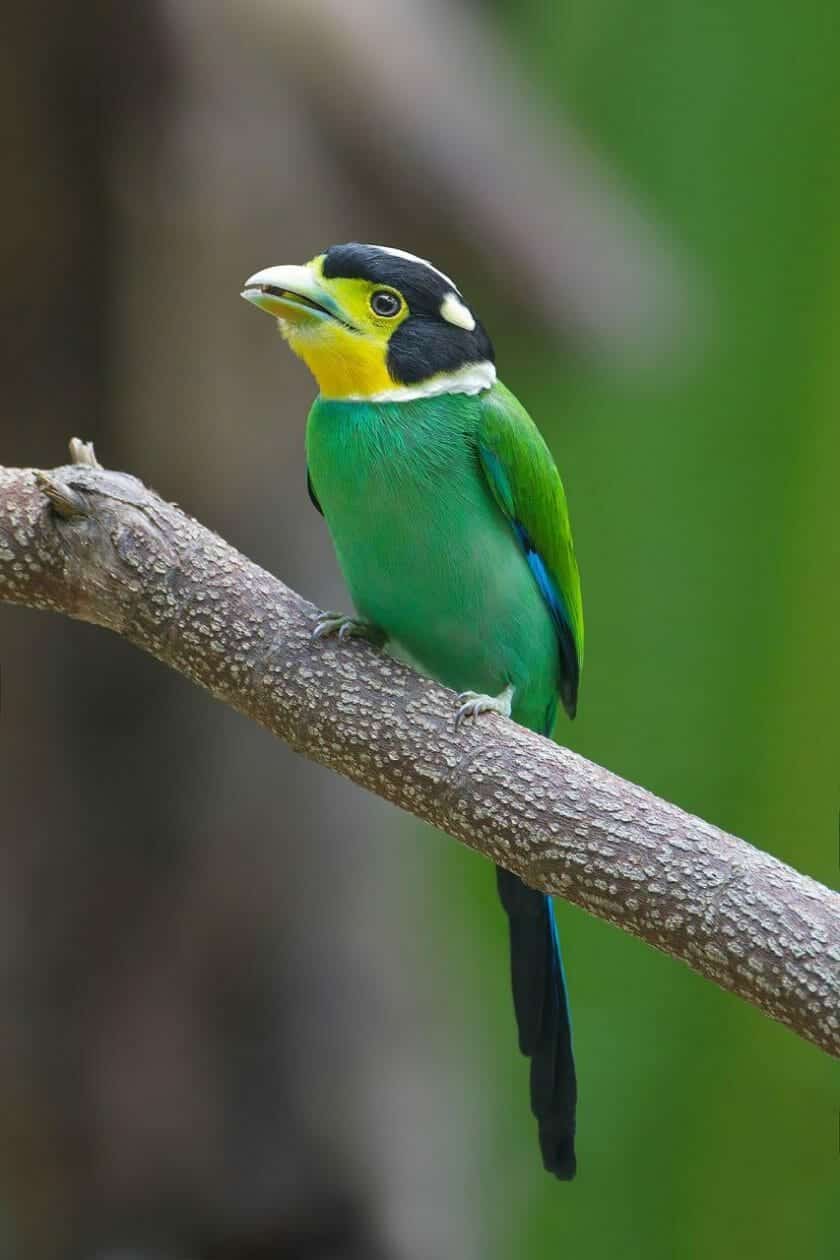
Broadbills
Broadbills
Many of the broadbills are brightly coloured birds. They range from 13 to 28 centimetres in length, and live in the dense canopies of wet forests, allowing them to hide despite their brightly coloured plumage. The plumage of the three African broadbills in the genus Smithornis is in contrast dull and streaked. The bills, which give the family their common name, are broad, flat and hooked.
Bronze-winged Pionus
Bronze-winged Pionus Parrots (Pionus chalcopteru)
Bronze Wings are small parrots measuring around 11 to 11.6 inches (~ 29 cm) in length. They are almost purple in coloration, and their true beauty is appreciated in natural sunlight as seen in the picture to the right. They have a pronounced bronze patch on the wings. The head and nape (back of the neck) is bronze-brown. The feathers are broadly edged dark violet-grey. The chin is white. The throat is dull pink. The back, rump and shoulder feathers are dark bronze-green with blue edging. The breast and abdomen are dark green broadly edged with dark violet-blue. The under tail-coverts are red. The wing-coverts are bronze-brown. The primary wing feathers and primaries (= longest wing feathers) are purple-blue. The tail is dark blue and the outer feathers have a red base. The eye rings are white to pinkish in coloration. The irides (= plural of iris) are brown and the feet flesh-colored. The bill is horn colored.
Immature birds have a greenish head and back. Their breast and abdomen feathers have a dark green edging.
Brotogeris

Brotogeris
Members of the Brotogeris are swift fliers. They are smaller than cockatiels, with an average length of 7-9″ from head to tail. The sub-species range from 6.8 – 10 inches or 17 – 25 cm in length (including tail). The plumage is predominantly green. Depending on the species, they also have varying markings of yellow, white, blue, orange and grey on their wings and head.
Brotogeris in Aviculture:
They were imported into the United States through the 1980s in relatively high numbers. Most of the imported birds were pulled from their nests and handraised, so they arrived here relatively tame, which made them attractive as pets, rather than being placed into breeding programs. Nowadays, these parakeets are no longer imported because of export restrictions that were implemented to protect these species and as insufficient numbers of them were set up in breeding programs – not all of which were successful – the brotogeris parakeets are now difficult to find. In fact, several of these species are at risk of dying out in the United States.
Brown Boobies
Brown Boobies
The Brown Booby breeds on islands and coasts in the pantropical areas of the Atlantic and Pacific oceans, as well as frequenting the breeding grounds of the islands in the Gulf of Mexico and the Caribbean Sea.

Brown-hooded Parrots
Brown-hooded Parrots
The Brown-hooded Parrot averages 8 – 8.4 inches (21 cm) in length and weighs around 165 g.
The adult plumage is generally green, with an olive tone to the breast. The head and neck is brown, darker on the face – especially in males. They have distinctive red ear patches. The wings have blue outer primaries (longest wing feathers) and red linings which show well in flight, and the tail has reddish sides. The eye-ring and bill are pale. The irides (= plural of iris) are red and the feet brownish-grey.
Young birds are similar to the adults, but are paler and duller, and without red on the head. Their irides (= plural of iris) are dark.
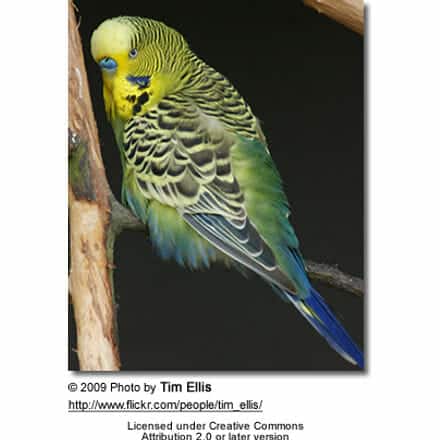
Budgerigar aka “Budgie” – One of the most popular pet birds and one of the best TALKING birds
These colorful birds are native to Australia where they are naturally distributed throughout the continent; however, occurring more in the drier interior of the continent and the coastal areas in the far east and the far south-west. This species is said to have survived in the inlands of Australia for over 5 million years.
Budgies favor open habitats and are commonly found in scrublands, open woodland and grassland, always near bodies of water.
Within their natural range, flocks of them generally migrate north for the winter; this seasonal movement is tied to the availability of food and water. Drought conditions can also drive them into more wooded habitat or coastal areas.
They have been introduced to many areas around the world including New Zealand, Japan, Europe, southern Africa, continental United States and Puerto Rico. However, the only place were feral populations appear to have established themselves outside of Australia is west central Florida, USA, where they have been recorded in St. Petersburg since the 1940s. However, their numbers in Florida have been declining probably due to competition with other birds (such as starlings).
These sociable birds are usually found in small groups and under favorable conditions in large flocks. As most birds, their activities begin just before sunrise with some movement within the trees, singing and mutual preening. After sunrise, they fly to their foraging areas, where they feed throughout most of the day – except during midday or in extremely hot weather, when they typically rest in the shady canopy or other shaded location.
In the early evening, they return to their roosting sites for the night.
Bulbuls
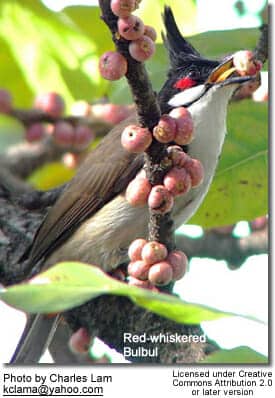
Bulbuls – Pycnonotidae
This family occurs across most of Africa and into the Middle East, tropical Asia to Indonesia, and north as far as Japan. A few species are found on the tropical islands of the Indian Ocean.
The African species are predominately found in rainforest. In Asia, they are more likely to be found in open areas.
Bunting
Lark Buntings
Buntings are a group of mainly European seed-eating birds with stubby, conical bills.
They are found in the Old World (Europa, Asia, and Africa).
Bushtits
Bushtits
The Bushtit (Psaltriparus minimus) is a long-tailed tit found in North America, where it inhabits mixed open woodlands, often containing oaks and a scrubby understory. Bushtit flocks typically consists of I0 to 40 or more individuals.
Butcherbirds
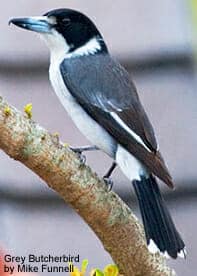
Butcherbirds
Butcherbirds are magpie-like songbirds that are native to Australasia. They were named for the way they store their prey — hanging captured animals on a thorn, tree fork or crevice to support them while they are being eaten, or to store them for later consumption.



